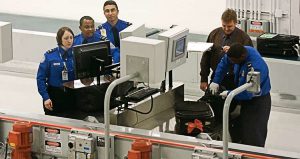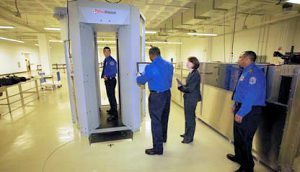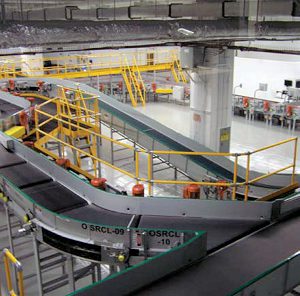 |
|
Facts & Figures Project: Transportation Systems Integration Facility Operator: Transportation Security Administration Location: Ronald Reagan Washington National Airport Building Size: 128,000 sq. ft. Cost: $25.5 million (design and buildout/renovations) Lease: 10 years Estimated Annual Operating Costs: $4 million Employees: 140 Design/Construction: Vic Thompson Company Baggage Handling System Supplier: G&S Airport Conveyor BHS Size: More than 1/2 mile of conveyors BHS/Facility Design Review, Commissioning & Construction Administration: Jacobs Engineering BHS Testing (including Integrated Site Acceptance Testing): Jacobs Engineering and CAGE Inc. BHS Training: Vic Thompson Company BHS Controls & Reports: Brock Solutions Checked Baggage Screening Systems: GE, L-3, Reveal and Smiths Detection Passenger Screening Equipment: CEIA Enhanced Metal Detector; Rapiscan and L-3 Whole Body Imagers; Rapiscan SmartLane Advanced Technology (AT) X-Ray; Smiths iLane AT X-Ray; Analogic Cobra Auto-EDS; Spectrum Castcope Contract Maintenance: Vic Thompson Company, G&S Airport Conveyor |
“There’s nothing in the world like it,” says Jim Goertz, president of G&S Airport Conveyor. “It gives TSA a huge leg up in testing how equipment works under real working conditions.” G&S, which manufactured and built TSIF’s sprawling baggage handling system, has presented plans for a much smaller version to the Canadian government.
The ability to test how various systems interface with existing baggage handling systems is of particular value, as is experimenting with how new systems will physically fit into the unusual layouts common in some airports.
CAGE Inc. provided static, integrated site acceptance testing, dynamic and functional testing of the CBIS BHS. This included complete mechanical and electrical BHS professional commissioning services.
“The facility’s ability to evaluate concepts of operation, measures of performance, measures of effectiveness and varying equipment arrangements makes it a highly useful tool,” says Susan Prediger, vice president of CAGE. “TSA can now emulate realistic operational environments to integrate and evaluate technologies, processes, procedures and staff to optimize existing and future EDS systems. It also evaluates associated maintenance, space and construction issues. The TSIF lessons learned will improve reliability and reduce risks associated with the deployment and integration of EDS equipment into new and legacy systems.”
Cargo testing occurs in an area adjacent to the baggage handling system. Testing equipment to help airports meet the coming mandate for screening of 100% of air cargo is expected to begin midsummer and last at least four to five months, estimates Keith Goll, general manager, OST Operational Support.
Again, testing at TSIF vs. in the field is anticipated to yield impressive savings. Pre-deployment testing of air cargo screening equipment is expected to save $4 million – the same amount as the entire facility’s annual operating budget.
“It will also shift our timeline to the left, saving about four months throughout the process,” adds Kane.
In June, 13 different cargo systems were officially being considered for testing at TSIF. Equipment already at airports for preliminary evaluation was being pulled back for testing at the new facility.
Eventually, TSA may also test screening systems for use in maritime and rail venues at TSIF.
When acting TSA administrator Gale Rossides visited TSIF shortly after it opened in February, she noted that simply having employees and testing equipment located in the same building – a new dynamic for TSA – is
 |
Upstairs Operations
Passenger screening predominates the second floor at TSIF. The facility’s full-size checkpoint includes advanced technology X-ray equipment manufactured by Rapiscan and Smiths, an explosive detection screening unit manufactured by Analogic and whole body imaging machines manufactured by L-3 and Rapiscan.
It’s not, however, just about equipment. Configurations and procedures are also put to the test. The full-size checkpoint allows TSA testers to experiment with various designs and operational strategies.
 |
Eventually, TSIF employees will take turns staffing the checkpoint as mock passengers play out various scenarios. The facility is not, however, intended to become a site to train transportation security officers from the field on equipment operation.
Between equipment and personnel procedures, the long-term systemwide efficiencies TSIF will provide are expected to be “very significant,” says Kane.
“It’s a capability we were missing,” he reflects. “TSIF allows us to get things right as they come out of the box. With thousands of pieces of equipment out in the field, little inefficiencies in operation, reliability and maintainability really add up.”
Added Capabilities
Explosives certification testing for TSA-approved equipment will still occur at the department’s lab in Atlantic City, while TSIF will focus on qualification testing of operational aspects.
The screened baggage handling system, designed by Vic Thompson Company, was engineered to facilitate continual updates to the equipment being testing – “plug and play” as some characterize it.
 |
Each of the system’s 240 conveyors has its own frequency drive, Goertz notes. “This allows operators to adjust the speed up or down as needed with just the click of a mouse. They can get very specific in testing throughput rates.”
In June, five explosive detection system machines were being tested: The Reveal CT-80 DR, GE’s CTX 9400, the Examiner 6400 by L-3, Smiths’ Heimann EDtS 10080 and L-3’s Analogic XLB.
“Having machines side-by-side makes it easy to compare speed, screen resolution and reliability,” says Goertz. “TSIF is like a lab, but it’s also like a real working airport.”
In addition to installing its own high-speed vertical sorters and single-paddle diverters, G&S installed vertical sorters and horizontal diverters from Siemens and Vanderlande, vertical sorters by Jervis B. Webb and pushers and horizontal diverters from G&T.
In addition to testing equipment and procedures, TSIF is also expected to help TSA keep the planning guidelines and design standards (PGDS) it provides to potential equipment manufacturers “fresher” and more attuned to current and future airport needs – something it has been criticized for in the past.
“TSIF directly benefits all stakeholders,” notes Prediger. “It helps develop solutions and approaches to resolve key issues. Evolving security requirements, emerging technologies, lifecycle issues, testing protocols and application of lessons learned can all be verified at TSIF and incorporated into the PGDS for clear communication to industry.”
There’s even enthusiasm overseas about TSA’s new facility. “Our international partners are excited about its capabilities,” says Kane. “It will help increase standardization and harmonization with other security organizations and our counterparts in foreign governments.”
High-Level Validation
Given the wide-scale efficiencies and cost-savings it is expected to deliver, TSIF proved to be a strategic location for the spring press conference that launched the Department of Homeland Security’s Efficiency Review initiative. With plenty of public attention on fellow DHS entities such as U.S. Customs and Border Protection, Immigration Services and the Federal Emergency Management Agency, TSA provided the federal umbrella department with good news to showcase.
“This very facility is a great example of efficiency at work,” said DHS secretary Janet Napolitano. “I am committed to creating a new culture of efficiency at the Department of Homeland Security, and the Efficiency Review will allow us to cut costs while streamlining operations and decision-making. Over time, this will make DHS a leaner, smarter agency better equipped to protect our nation.”
When Napolitano made her appearance at TSIF in late March, 50 employees were working at the new facility. By June, it was fully staffed with approximately 140 employees.


